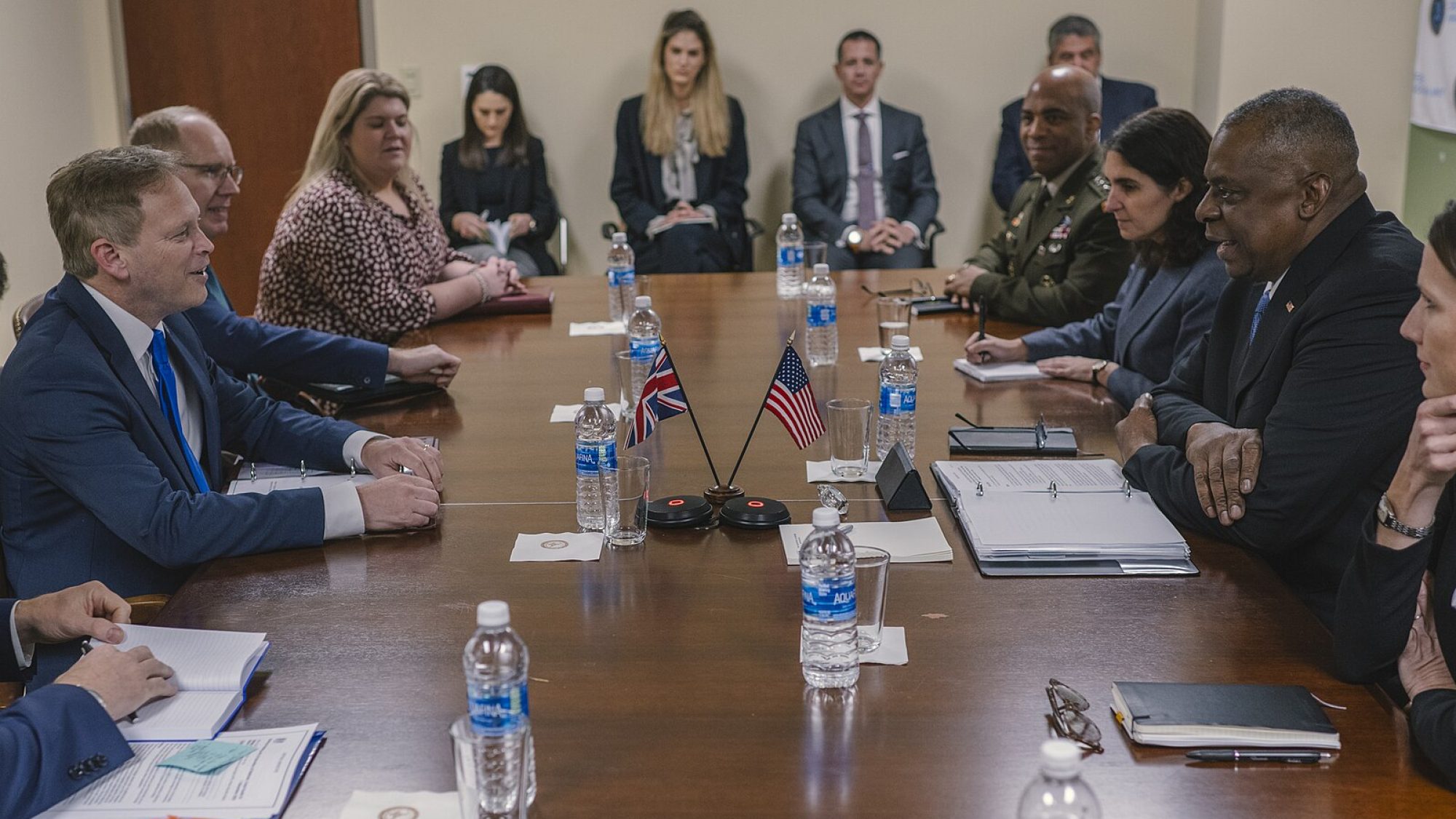
Title: Opportunities and Challenges of AUKUS
President Biden’s approval of the 2024 National Defense Authorization Act (NDAA) will facilitate key aspects of the Australia-United Kingdom-United States technology cooperation partnership (AUKUS). Australia, the United Kingdom, and the United States have long enjoyed the closest defense relationships, but AUKUS will further enhance the security interests of the participants. It will do so by extending cooperation and access to advanced capabilities to a deeper sharing and integration of science, industrial bases, and supply chains. The partnership will benefit each participant — but is not without its challenges.
What is AUKUS?
AUKUS was announced in September 2021 to support the Royal Australian Navy (RAN) in acquiring nuclear-powered submarines. The significance of this decision, with Australia becoming the first non-nuclear weapon state to acquire such a capability, overshadowed a second initiative for the three nations to share other technologies to enhance joint capabilities and interoperability. These two initiatives are referred to as Pillars 1 and 2.
The strategic rationale for Pillar 1 is to build the combined capabilities of the AUKUS partners to deter threats to security and stability in the Indo-Pacific region through a potent and interoperable submarine force. Australia’s shift will boost its undersea capability by exploiting nuclear-powered submarines’ advantages of range, endurance, and stealth. Yet, introducing these submarines into service is a substantial undertaking, especially for a non-nuclear state. The timeframe for such a transition is significant; constructing Australia’s eight desired nuclear-powered submarines will take more than two decades — a timeframe out of step with the urgent nature of the rationale and Australia’s assessment that it can no longer rely upon previous assumptions of a ten-year strategic warning of conflict.
The temporal contradiction is partially redressed by Australia’s articulation of a pathway to achieve its nuclear-powered submarine capability. This pathway begins with the immediate introduction of personnel exchanges and will be followed by the rotational presence of UK and U.S. submarines in Western Australia beginning in 2027. Australia will acquire at least three Virginia Class nuclear-powered attack submarines (SSNs) in the early 2030s ahead of the new SSN-AUKUS submarines built for the Royal Navy (from the late 2030s) and RAN (from the early 2040s).
Pillar 2 is concerned with shared technology and increased interoperability in advanced capabilities. The four initial workstreams under Pillar 2 (cyber, artificial intelligence, quantum, and undersea technologies) were expanded to eight in 2022, with hypersonic and electronic warfare key additions. It is in these areas that the partnership seeks to achieve advantage, in a way that was previously characterized as a potential third offset for the U.S. DoD. They are technology areas in which all three nations have established programs, but in which coordinated development (beyond extant five eyes government to government technology cooperation) may see greater and earlier returns.
The promise of Pillar 2 has seen speculation of extending the partnership to various other nations, including Japan, France, Canada, and New Zealand, although much of the focus has been on the resultant acronyms rather than the value of expanding the partnership. Engagement with officials involved in AUKUS indicates that a formal expansion to other partners is unlikely; however, the value of technology cooperation with such nations is clear and is expected to be extended on a project-by-project basis.
In considering the benefits of AUKUS, it is important to recognize that while it will enhance deterrence, it is not a commitment to respond to crises, nor is it a substitute for other relationship arrangements. It also is not about providing access to one nation’s advanced capabilities, nor about enhancing the already close ties between the military forces, even though it should lead to better capability and interoperability. Rather, it is concerned with greater integration of the broader defense sectors across the three nations, in research and development, production, and supply chains, thus strengthening the collective innovation system, including the transition of R&D efforts into operational capability. This will lead to new relationships across the AUKUS partners in academia, industry, and civil society.
The Opportunities
For the United States, AUKUS will boost collaboration, innovation, interoperability, and collective capability, thus strengthening integrated deterrence against adversarial actors, especially in the Indo-Pacific. Key to its success will be to reconcile the differences between domestic policies and external cooperative opportunities, as well as an ongoing U.S. commitment to the Indo-Pacific and to empowering its closest allies.
For Australia, the United States alliance remains central to its security, and the AUKUS partnership is consistent with Australia’s intent to deepen bilateral defense cooperation. Increased defense capability strengthens Australia’s ability to be an effective security partner and contribute to regional stability. Australian leaders see AUKUS as contributing to a balance of power grand strategy to deter aggression and coercion.
For the United Kingdom, the partnership serves the purposes of stimulating the defense industry and assuring the future submarine program (to replace the Astute SSN). It also aligns with the UK’s renewed focus on the security of the Indo-Pacific, as well as the Ministry of Defence’s shift to a technology-centric approach to capability.
For all three partners, AUKUS will provide value through outcomes of deterrence, increased interoperability and capability, and the support of an integrated industrial base. It also promises value from an input perspective, in terms of more efficient and coordinated development and support of advanced capabilities.
The Challenges
The announcement of Australia’s intent to acquire nuclear-powered submarines led to an immediate outcry about nuclear proliferation, ranging from the PRC’s outright opposition to wider concerns about the precedent it creates. The latter led the partner nations to commit to strong standards for safety and non-proliferation. There remains uncertainty within the Southeast Asian region as to whether Pillar 1 represents a net contributor to security or a source of instability. Australia’s intent to acquire nuclear-powered submarines also resulted in a deterioration of Australia’s relations with France following the cancellation of plans to acquire diesel-electric Attack Class submarines, although relations have since improved.
A second Pillar 1 challenge is the enormous uplift in workforce skills and numbers required in Australia to build, operate, and support nuclear-powered submarines. This uplift is required at a time when Australia is facing low rates of unemployment and other industries’ demand for skilled personnel. Building this workforce will require policy interventions concurrent with the pathway for introduction of the future submarines.
Other Australian concerns include the significant cost of the submarine program and whether it has public support. Some critics question the underlying strategy of relying upon U.S. commitment in Asia, its implications for sovereignty, and the dependence of the submarine pathway on a future U.S. administration. Yet, there remains a strong commitment to Pillar 1 from the Albanese government.
In the United States, initial apprehension about the sharing of nuclear-powered submarine technology, for the first time since sharing with the United Kingdom half a century ago, gave way to consternation about the capacity of U.S. shipyards to support the provision of Virginia Class submarines for Australia. Australia has sought to mitigate such risks through a ‘unique’ arrangement that involves investing in the expansion of U.S. production and long lead items.
Another challenge lies in reforming the International Trade in Arms Regulations (ITAR) to enable technology cooperation under the AUKUS partnership. ITAR does not readily provide favorable treatment to close allies and requires numerous changes to facilitate AUKUS. Even if the necessary reforms are achieved, the United States expects its partners to lift their standards in export control. Australia is seeking to strengthen its defense trade control regime, which will improve cooperation with AUKUS partners but has caused alarm in scientific communities concerning its impact on engagement with other partners.
Where to from here?
Much of the way forward for AUKUS is included in the 2024 NDAA, with sections 1331 to 1333 establishing governance arrangements, sections 1341 to 1345 addressing changes in ITAR, and sections 1351 to 1354 facilitating Australia’s acquisition of nuclear-powered submarines. Section 1080 also expands the Defense Production Act to include Australia and the UK within an integrated industrial base. Inherent within these authorizations is a requirement for the DoD to report progress and performance to Congress.
With NDAA approval at the end of 2023, associated U.S. commitments to AUKUS became law. Australian legislative changes to strengthen defense trade controls have been referred to a committee and are expected to be reconsidered by parliament during 2024. However, demonstrable progress in the implementation of these laws will need to be accompanied by shifts in information sharing and coordination in planning, if AUKUS is to realize its full potential.
While Section 1332 of the NDAA directs reduced use of the NOFORN caveat, there has been previous presidential direction in relation to NOFORN and intelligence sharing, as well as departmental direction regarding the use of the caveat in non-intelligence information. Yet over-classification remains an impediment to allied cooperation, with the issue being a failure of such directives to flow to national disclosure policies and associated processes.
As previously noted, the key characteristic of AUKUS is that it is concerned with information sharing between defense sectors, not just between defense departments. This effectively increases the attack surface for intelligence threats to target supply chains in allied academia and industry. Thus, changes to defense trade control legislation need to be accompanied by a range of mechanisms to not only support information sharing through mutual recognition of defense industry security clearances and processes but also assure that security arrangements provide adequate protection of information.
The ultimate success of AUKUS will lie not only in the cooperation in technological development but also in the application of advanced allied capabilities and the full suite of efforts to strengthen integrated deterrence. AUKUS has potential implications for and from operational concepts, including Agile Combat Employment, Force Posture Initiatives, and the UK’s Integrated Operating Concept. There is also a case for greater interaction and integration of enablers, including agencies such as Naval Reactors and the Australian Submarine Agency, and between national defense innovation and acquisition agencies.
Increased allied engagement in defense planning processes would help optimize AUKUS cooperation. The Congressionally mandated Commission on Planning, Programming, Budgeting, and Execution (PPBE) Reform identified dependencies between U.S. PPBE processes and those of its close allies. While requirements harmonization has recently been enhanced through the establishment of the new International JROC, further integration throughout planning and capability lifecycles may help the AUKUS partners realize the full value of AUKUS.
Despite the risks of AUKUS, the prevailing view amongst officials and the broader defense community is that “the juice is worth the squeeze.” Whether this view holds up under a long-term partnership depends upon whether the participants remain committed to not only the execution of the Pillar 1 and 2 programs but also broader efforts to manage risks and realize the full potential of technology cooperation.
…
Andrew Dowse is the director of RAND Australia and a retired Royal Australian Air Force officer, having held general officer positions as the Australian J6, as well as in strategy, planning, and capability development. He is an electronic engineer with a PhD from the University of New South Wales.
Image Credit: Wikimedia Commons
Recommended Articles

This article explores the uncertain future of Arctic governance amid shifting global geopolitics. It argues that whether Washington and Moscow opt for confrontation or cooperation, multilateralism in the Arctic…

Twenty-five years ago, the United Nations Security Council adopted Resolution 1325, establishing a framework that underpins the Women, Peace, and Security (WPS) Agenda. The Resolution recognized both the…

When we analyze conflicts in the Middle East, we are not analyzing conflicts with isolated impacts but risks for global energy security. Recent conflicts in the Middle East have highlighted…